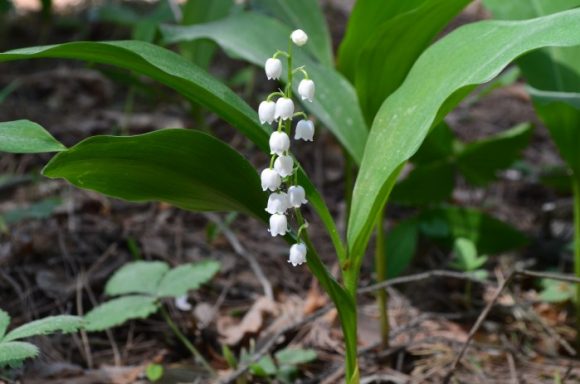- The Miraculous Shiny Bush Plant - January 18, 2021
- Colorful, Edible and Medicinal Celosia - January 10, 2021
- Radish, a Nutritional Power House - December 19, 2020
The lily of the valley, botanically known as convallaria majalis, or lillium convallium, is a perennial, flowering plant native to North Asia, England, and North America. It has creeping rhizomes that send up shoots. The shoots featuring a pair of leaves, uncoil as they lengthen and extend upwards.
[Note: The Right Flowers is not a medical site. Knowledge of and information about the therapeutic benefits and applications of flowers, while known through the ages, does not constitute medical advice. If you are having health issues, you should consult with a physician.]
The plant thrives in well-drained, moist soils. It produces beautiful, fragrant, white bell-shaped flowers. As the blossoms open, they turn downwards.
The lily of the valley is a subject of many myths. A popular Greek myth holds that the plant was given to Aesculapius, the Roman god of medicine by Apollo, the sun god. Another Christian myth claims that blossoms of the lily of the valley represent Virgin Mary’s tears. These myths and legends, coupled with the beauty of the flowers explain why bouquets of this fragrant and showy blossoms are carried by brides for prosperity and good luck.
This plant contains more than 30 glycosides including convallarin and convallamarin. These two compounds have diuretic and purgative qualities. The plant is also rich in essential oils, saponins, malic acid, flavonoids, citric acid and cardenolides.
As far back as the 4th century, the lily of the valley was used as a heart tonic to regulate heartbeat. It is believed that the aerial parts of the plant contain compounds with a tonic effect on the heart. Nicholas Culpeper, the 17th-century physician and botanist, held that the plant was great for improving weak memories, alleviating eye infections and assisting people with palsy.
The lily of the valley’s fame as a heart tonic is no idle talk as its flowers and leaves are known to contain heart-friendly glycosides including convallatoxin, lokunjoside, and convallosides. These are the primary cardiac glycosides in the plant that make it an ideal heart tonic. At a basic level, cardiac glycosides are used to enhance the functioning of the myocardium. They cause the heart to pump more forcefully without increasing the need for oxygen, making the heart more efficient.
Convallatoxin, one of the main cardiac glycosides in the plant is critical in resolving cardio-vascular problems for reducing high blood pressure, treating strokes and preventing as well as treating cardiac failure. The glycoside which is known to work similarly to digitalis, has fewer side effects and less demanding on the kidneys. Digitalis, while being popular for treating heart conditions, tends to damage the heart in the long term. However, convallatoxin is gentle on the heart and does not damage heart muscles. The herb is quick-acting and has a relatively short half-life.
In the light of the information outlined above, now you know that lily of the valley not only warms your heart with its beauty but also contains natural chemicals that are beneficial for the heart.





